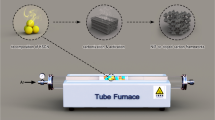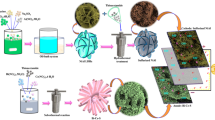Abstract
One-dimensional (1D) hollow-structured nanomaterials with desirable compositions have aroused huge attention in the field of electrochemical energy storage. In the present study, 1D hierarchical cobalt hexacyanoferrate (CoHCF) microtubes were initially fabricated using a facile self-templated method with the electrospun polyacrylonitrile (PAN)-cobalt acetate (Co(Ac)2) as templates. After the chemical reaction was performed between the templates and a potassium ferricyanide solution, the core-shell PAN-Co(Ac)2@CoHCF nanofibers were successfully fabricated. Subsequently, the CoHCF microtubes were finally obtained via the selective dissolution of the PAN-Co(Ac)2 cores. Benefiting from the unique structural characteristic, the CoHCF microtubes electrode exhibited prominent electrochemical characteristics in Na2SO4 aqueous electrolyte, including a high specific capacitance of 281.8 F g−1 (at 1 A g−1), and good rate capability as well as long cycling stability (93% capacitance retention after 5000 cycles). The hybrid supercapacitor assembled with CoHCF microtubes and activated carbon (AC) as the positive and negative electrodes, respectively, exhibited a high energy density of 43.89 W h kg−1, a power density of 27.78 kW kg−1, as well as a long cycle life. Note that this versatile self templated synthetic strategy could be extended to fabricate other 1D hollow Prussian blue (PB) or its analogues (PBA) with controllable composition, which have a potential application in a range of fields.
摘要
在电化学储能领域, 具有可控组成的一维空心结构纳米材料引起了人们的极大关注. 本文以静电纺丝制备的聚丙烯腈(PAN)-醋酸钴(Co(Ac)2)纳米纤维为模板, 首次采用简易的自模板法制备了一维铁氰化钴(CoHCF)空心微米管. PAN-Co(Ac)2纳米纤维模板与铁氰化钾溶液反应, 合成了核壳结构的PAN-Co(Ac)2@CoHCF纳米纤维; 随后, 选择性溶解去除PAN-Co(Ac)2芯部, 从而得到CoHCF空心微米管. 得益于其独特的结构优势, CoHCF空心微米管电极在Na2SO4 电解液中表现出优异的电化学性能, 如高比电容(281.8 F g−1@1 A g−1), 良好的速率性能和长时间循环稳定性(5000次循环后电容保持率为93%). 由CoHCF为**极和活性炭(AC)为负极组装的非对称超级电容器, 具有43.9 W h kg−1的高能量密度、 20 kW kg−1的功率密度以及长的循环寿命. 更重要的是, 这种通用性的自模板合成策略可以推广到其他组成可控的一维空心普鲁士蓝(PB)及其类似物(PBA)材料, 因而在很多领域具有广泛的应用前景.
Similar content being viewed by others
References
Wang X, Feng J, Bai Y, et al. Synthesis, properties, and applications of hollow micro-/nanostructures. Chem Rev, 2016, 116: 10983–11060
Lai X, Halpert JE, Wang D. Recent advances in micro-/nanostructured hollow spheres for energy applications: From simple to complex systems. Energy Environ Sci, 2012, 5: 5604–5618
Yu L, Wu HB, Lou XWD. Self-templated formation of hollow structures for electrochemical energy applications. Acc Chem Res, 2017, 50: 293–301
Zheng M, **ao X, Li L, et al. Hierarchically nanostructured transition metal oxides for supercapacitors. Sci China Mater, 2018, 61: 185–209
Liu J, Wu C, **ao D, et al. MOF-derived hollow Co9S8 nanoparticles embedded in graphitic carbon nanocages with superior Li-ion storage. Small, 2016, 12: 2354–2364
Zhu YP, Ma TY, Jaroniec M, et al. Self-templating synthesis of hollow Co3O4 microtube arrays for highly efficient water electrolysis. Angew Chem Int Ed, 2017, 56: 1324–1328
Yin X, Li H, Han L, et al. Lightweight and flexible 3D graphene microtubes membrane for high-efficiency electromagnetic-interference shielding. Chem Eng J, 2020, 124025
Kim C, Jung JW, Yoon KR, et al. A high-capacity and long-cycle-life lithium-ion battery anode architecture: Silver nanoparticle-decorated SnO2/NiO nanotubes. ACS Nano, 2016, 10: 11317–11326
Yin X, Li H, Wang H, et al. Self-templating synthesis of cobalt hexacyanoferrate hollow structures with superior performance for Na-ion hybrid supercapacitors. ACS Appl Mater Interfaces, 2018, 10: 29496–29504
Lou XWD, Archer LA, Yang Z. Hollow micro-/nanostructures: Synthesis and applications. Adv Mater, 2008, 20: 3987–4019
Jia R, Li L, Ai Y, et al. Self-healable wire-shaped supercapacitors with two twisted NiCo2O4 coated polyvinyl alcohol hydrogel fibers. Sci China Mater, 2018, 61: 254–262
Wang Z, Zhou L, David Lou XW. Metal oxide hollow nanostructures for lithium-ion batteries. Adv Mater, 2012, 24: 1903–1911
Li Z, Wu HB, (David) Lou XW. Rational designs and engineering of hollow micro-/nanostructures as sulfur hosts for advanced lithium-sulfur batteries. Energy Environ Sci, 2016, 9: 3061–3070
Peng S, Li L, Hu Y, et al. Fabrication of spinel one-dimensional architectures by single-spinneret electrospinning for energy storage applications. ACS Nano, 2015, 9: 1945–1954
Liu J, Qiao SZ, Budi Hartono S, et al. Monodisperse yolk-shell nanoparticles with a hierarchical porous structure for delivery vehicles and nanoreactors. Angew Chem Int Ed, 2010, 49: 4981–4985
Zhang L, Wu HB, Madhavi S, et al. Formation of Fe2O3 microboxes with hierarchical shell structures from metal-organic frameworks and their lithium storage properties. J Am Chem Soc, 2012, 134: 17388–17391
Kong B, Selomulya C, Zheng G, et al. New faces of porous Prussian blue: Interfacial assembly of integrated hetero-structures for sensing applications. Chem Soc Rev, 2015, 44: 7997–8018
Hu M, Belik AA, Imura M, et al. Synthesis of superparamagnetic nanoporous iron oxide particles with hollow interiors by using Prussian blue coordination polymers. Chem Mater, 2012, 24: 2698–2707
Zhang M, Hou C, Halder A, et al. Interlocked graphene-Prussian blue hybrid composites enable multifunctional electrochemical applications. Biosens Bioelectron, 2017, 89: 570–577
Nossol E, Zarbin AJG. A simple and innovative route to prepare a novel carbon nanotube/Prussian blue electrode and its utilization as a highly sensitive H2O2 amperometric sensor. Adv Funct Mater, 2009, 19: 3980–3986
Xu Y, Zheng S, Tang H, et al. Prussian blue and its derivatives as electrode materials for electrochemical energy storage. Energy Storage Mater, 2017, 9: 11–30
Wang JG, Zhang Z, Zhang X, et al. Cation exchange formation of Prussian blue analogue submicroboxes for high-performance Na-ion hybrid supercapacitors. Nano Energy, 2017, 39: 647–653
Zhao Y, Liu J, Horn M, et al. Recent advancements in metal organic framework based electrodes for supercapacitors. Sci China Mater, 2018, 61: 159–184
Jiang Y, Yu S, Wang B, et al. Prussian blue@C composite as an ultrahigh-rate and long-life sodium-ion battery cathode. Adv Funct Mater, 2016, 26: 5315–5321
You Y, Wu XL, Yin YX, et al. High-quality Prussian blue crystals as superior cathode materials for room-temperature sodium-ion batteries. Energy Environ Sci, 2014, 7: 1643–1647
Xue L, Li Y, Gao H, et al. Low-cost high-energy potassium cathode. J Am Chem Soc, 2017, 139: 2164–2167
Wessells CD, McDowell MT, Peddada SV, et al. Tunable reaction potentials in open framework nanoparticle battery electrodes for grid-scale energy storage. ACS Nano, 2012, 6: 1688–1694
Ren W, Qin M, Zhu Z, et al. Activation of sodium storage sites in Prussian blue analogues via surface etching. Nano Lett, 2017, 17: 4713–4718
Jia H, Wang Z, Zheng X, et al. Interlaced Ni-Co LDH nanosheets wrapped Co9S8 nanotube with hierarchical structure toward high performance supercapacitors. Chem Eng J, 2018, 351: 348–355
Qiu X, Liu Y, Wang L, et al. Reverse microemulsion synthesis of nickel-cobalt hexacyanoferrate/reduced graphene oxide nanocomposites for high-performance supercapacitors and sodium ion batteries. Appl Surf Sci, 2018, 434: 1285–1292
Augustyn V, Come J, Lowe MA, et al. High-rate electrochemical energy storage through Li+ intercalation pseudocapacitance. Nat Mater, 2013, 12: 518–522
Augustyn V, Simon P, Dunn B. Pseudocapacitive oxide materials for high-rate electrochemical energy storage. Energy Environ Sci, 2014, 7: 1597–1614
Jia H, Wang Z, Li C, et al. Designing oxygen bonding between reduced graphene oxide and multishelled Mn3O4 hollow spheres for enhanced performance of supercapacitors. J Mater Chem A, 2019, 7: 6686–6694
Zhao F, Wang Y, Xu X, et al. Cobalt hexacyanoferrate nanoparticles as a high-rate and ultra-stable supercapacitor electrode material. ACS Appl Mater Interfaces, 2014, 6: 11007–11012
Wang JG, Zhang Z, Liu X, et al. Facile synthesis of cobalt hexacyanoferrate/graphene nanocomposites for high-performance supercapacitor. Electrochim Acta, 2017, 235: 114–121
Lu K, Li D, Gao X, et al. An advanced aqueous sodium-ion supercapacitor with a manganous hexacyanoferrate cathode and a Fe3O4/rGO anode. J Mater Chem A, 2015, 3: 16013–16019
Lu K, Song B, Gao X, et al. High-energy cobalt hexacyanoferrate and carbon micro-spheres aqueous sodium-ion capacitors. J Power Sources, 2016, 303: 347–353
Acknowledgements
This work was supported by the National Natural Science Foundation of China (51821091 and 51872233), and the Natural Science Foundation of Shaanxi Province (2018JM5044). We would like to thank the Analytical & Testing Center of Northwestern Polytechnical University for the morphology characterizations.
Author information
Authors and Affiliations
Contributions
Author contributions Yin X, Li H and Lu J designed the experiments. Yin X and Yuan R performed the material characterizations. Yin X wrote the paper with support from Zhang L. All authors contributed to the general discussion.
Corresponding authors
Ethics declarations
Conflict of interest The authors declare that they have no conflict of interest.
Additional information
Xuemin Yin is currently a PhD student at the School of Materials Science and Engineering, Northwestern Polytechnical University. His research focuses on the nanomaterials for electrochemical energy storage.
Hejun Li is a professor at the School of Materials Science and Engineering, Northwestern Polytechnical University. He received his PhD degree from Harbin Institute of Technology in 1991. His current research interests include advanced carbon/carbon composites, anti-oxidation coatings, paper based friction materials and nanomaterials.
**hua Lu is an associate professor at the School of Materials Science and Engineering, Northwestern Polytechnical University. Her current research interests include carbon/carbon composites and nanomaterials.
Rights and permissions
About this article
Cite this article
Yin, X., Li, H., Yuan, R. et al. General formation of Prussian blue analogue microtubes for high-performance Na-ion hybrid supercapacitors. Sci. China Mater. 63, 739–747 (2020). https://doi.org/10.1007/s40843-019-1251-8
Received:
Accepted:
Published:
Issue Date:
DOI: https://doi.org/10.1007/s40843-019-1251-8




